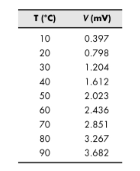Chemistry
10th Edition
ISBN:9781305957404
Author:Steven S. Zumdahl, Susan A. Zumdahl, Donald J. DeCoste
Publisher:Steven S. Zumdahl, Susan A. Zumdahl, Donald J. DeCoste
Chapter1: Chemical Foundations
Section: Chapter Questions
Problem 1RQ: Define and explain the differences between the following terms. a. law and theory b. theory and...
Related questions
Question
excel spreadsheet

Transcribed Image Text:Calibration Curve
6.3 Thermocouple
Thermocouples are made by joining two dissimilar metal wires. The contact of
the two metals results in a small, but measurable, voltage drop across the junc-
tion. This voltage drop changes as the temperature of the junction changes;
thus, the thermocouple can be used to measure temperature if you know the
relationship between temperature and voltage. Equations for common types of
thermocouples are available, or you can simply take a few data points and pre-
pare a calibration curve. This is especially easy for thermocouples because for
small temperature ranges, the relationship between temperature and voltage is
nearly linear.
Use a linear trendline to find the coefficients of a straight line through the data
shown here:
T (°C)
10
20
30
40
50
60
70
80
90
Problems 285
V (mv)
0.397
0.798
1.204
1.612
2.023
2.436
2.851
3.267
3.682
Note: The thermocouple voltage changes because the temperature changes-
that is, the voltage depends on the temperature. For regression, the indepen-
dent variable (temperature) should always be on the x axis, and the dependent
variable (voltage) should be on the y axis.
Expert Solution
Step 1
To determine: The coefficient of a straight line through the data.

Step by step
Solved in 4 steps with 3 images

Knowledge Booster
Learn more about
Need a deep-dive on the concept behind this application? Look no further. Learn more about this topic, chemistry and related others by exploring similar questions and additional content below.Recommended textbooks for you

Chemistry
Chemistry
ISBN:
9781305957404
Author:
Steven S. Zumdahl, Susan A. Zumdahl, Donald J. DeCoste
Publisher:
Cengage Learning

Chemistry
Chemistry
ISBN:
9781259911156
Author:
Raymond Chang Dr., Jason Overby Professor
Publisher:
McGraw-Hill Education

Principles of Instrumental Analysis
Chemistry
ISBN:
9781305577213
Author:
Douglas A. Skoog, F. James Holler, Stanley R. Crouch
Publisher:
Cengage Learning

Chemistry
Chemistry
ISBN:
9781305957404
Author:
Steven S. Zumdahl, Susan A. Zumdahl, Donald J. DeCoste
Publisher:
Cengage Learning

Chemistry
Chemistry
ISBN:
9781259911156
Author:
Raymond Chang Dr., Jason Overby Professor
Publisher:
McGraw-Hill Education

Principles of Instrumental Analysis
Chemistry
ISBN:
9781305577213
Author:
Douglas A. Skoog, F. James Holler, Stanley R. Crouch
Publisher:
Cengage Learning

Organic Chemistry
Chemistry
ISBN:
9780078021558
Author:
Janice Gorzynski Smith Dr.
Publisher:
McGraw-Hill Education

Chemistry: Principles and Reactions
Chemistry
ISBN:
9781305079373
Author:
William L. Masterton, Cecile N. Hurley
Publisher:
Cengage Learning

Elementary Principles of Chemical Processes, Bind…
Chemistry
ISBN:
9781118431221
Author:
Richard M. Felder, Ronald W. Rousseau, Lisa G. Bullard
Publisher:
WILEY